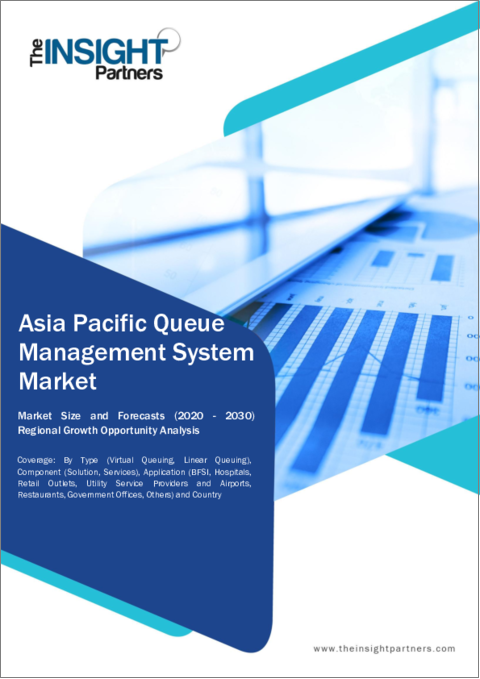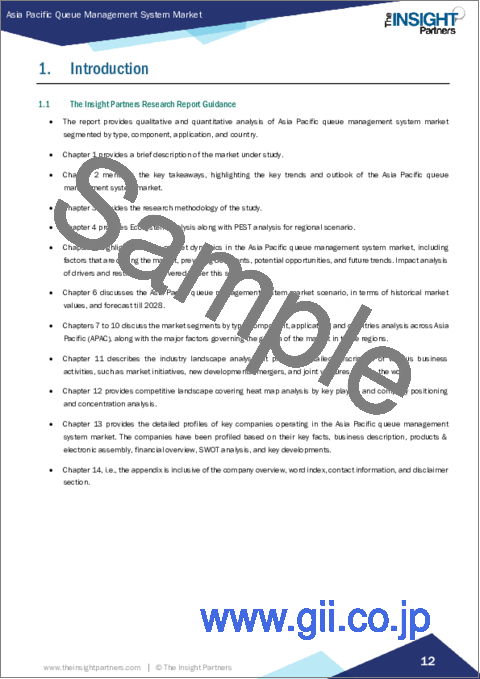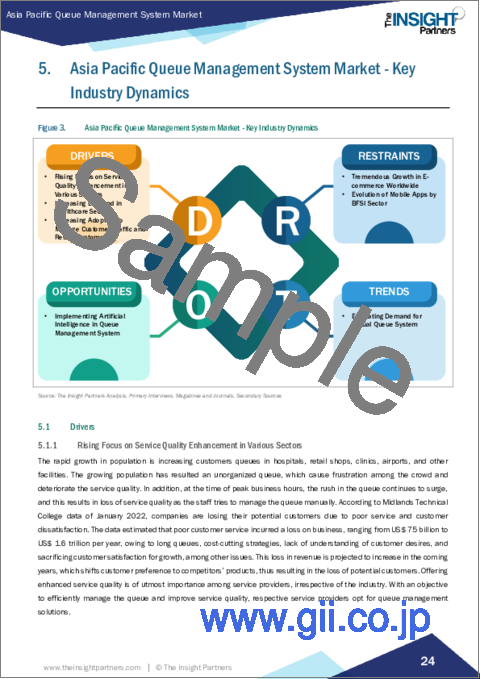|
|
市場調査レポート
商品コード
1494381
アジア太平洋の待ち行列管理システム:2030年市場予測- 地域別分析- タイプ別、コンポーネント別、用途別Asia Pacific Queue Management System Market Forecast to 2030 - Regional Analysis - By Type, Component, and Application |
||||||
|
|||||||
| アジア太平洋の待ち行列管理システム:2030年市場予測- 地域別分析- タイプ別、コンポーネント別、用途別 |
|
出版日: 2024年03月14日
発行: The Insight Partners
ページ情報: 英文 82 Pages
納期: 即納可能
|
- 全表示
- 概要
- 図表
- 目次
アジア太平洋の待ち行列管理システム市場は、2022年に1億1,508万米ドルと評価され、2030年には1億9,658万米ドルに達すると予測され、2022年から2030年までのCAGRは6.9%で成長すると予測されています。
待ち行列管理システムへの人工知能の導入がアジア太平洋の待ち行列管理システム市場を牽引
時間に関する顧客の期待の高まりが、サービスプロバイダーによる待ち行列管理システムの導入に影響を与えています。顧客からの苦情で最も多いのは、銀行、小売店、空港、病院、その他の公共の場での長い行列で、特にピーク時や休日が多いです。公共施設でサービスを受けるために、消費者はしばしば焦りやストレスを感じ、行列を進んでいく。さらに、世界保健機関(WHO)によると、老年人口の割合は2015年の12%から2050年には22%に増加すると予想されています。心血管疾患、骨粗しょう症、認知症を患う高齢者は、頻繁に病院を訪れる必要があります。国立衛生研究所のデータによると、2022年にはインドの老年人口の約21%が、アルツハイマー、関節炎、喘息、がんなど、少なくとも1つの慢性疾患を抱えています。同様に、高血圧と糖尿病は慢性疾患全体の68%を占め、これらの疾患により病院を訪れる患者の数が増加します。したがって、医療施設での長蛇の列は患者にとって物理的な負担となり、AIベースの待ち行列管理ソフトウェアに対する需要を生み出しています。
AIベースの待ち行列管理システムの使用は、ヘルスケアやその他の施設が顧客の問題を解決するのをサポートします。AIベースの待ち行列管理システムは、人工知能を活用して待ち時間を最小化し、待ち行列を管理し、患者のエクスペリエンスを向上させる。リアルタイムのデータを利用して顧客のトラフィックを予測し、それに応じてリソースを割り当てることで、顧客にシームレスで手間のかからない体験を提供します。AIベースの待ち行列管理システムは、顧客のフラストレーションを軽減し、全体的な顧客満足度の向上に役立ちます。このシステムは、顧客のトラフィックと待ち行列の長さをリアルタイムで監視し、ビジネスオーナーに正確なデータを提供して情報に基づいた意思決定を行うことができます。したがって、AIベースの待ち行列管理システムの導入は、予測期間中に市場企業にいくつかの成長機会を生み出す可能性が高いです。
アジア太平洋の待ち行列管理システム市場概要
アジア太平洋の待ち行列管理システムは、待ち行列管理システムの開発に従事している業界で認知された待ち行列管理システムメーカーの存在に起因して、2022年から2030年にかけて成長する可能性が高いです。アジア太平洋の数多くのテクノロジー新興企業は、業務効率を改善するためにAIをビジネスに導入することに注力しています。インターナショナル・データ・コーポレーション(IDC)の最新レポートによると、2023年9月時点で、アジア太平洋(日本を含む)の企業の26%がすでにジェネレーティブAI(GenAI)に投資しており、44%の企業はGenAIに投資する前に初期調査を実施しています。これらの企業は主に、製品開発・設計、研究開発、販売・マーケティング、顧客エンゲージメントの分野でAI技術の影響を受けています。待ち行列管理システムにAIを統合することで、顧客の待ち時間を短縮することができます。また、APACでは病院、銀行、小売店の数が大きく伸びており、同地域の待ち行列管理システム市場を活性化しています。
アジア太平洋の待ち行列管理システム市場の収益と2030年までの予測(金額)
アジア太平洋の待ち行列管理システム市場のセグメンテーション
アジア太平洋の待ち行列管理システム市場は、タイプ、コンポーネント、用途、国によって区分されます。
タイプ別では、アジア太平洋の待ち行列管理システム市場はバーチャル待ち行列とリニア待ち行列に二分されます。2022年には、バーチャル待ち行列のセグメントがより大きなシェアを占めています。
コンポーネント別では、アジア太平洋の待ち行列管理システム市場はソリューションとサービスに二分されます。2022年にはソリューション・セグメントがより大きなシェアを占めています。
用途別では、アジア太平洋の待ち行列管理システム市場は、BFSI、病院、小売店、公益事業者・空港、レストラン、官公庁、その他に区分されます。2022年にはBFSIセグメントが最大のシェアを占めています。
国別に見ると、アジア太平洋の待ち行列管理システム市場は、オーストラリア、中国、インド、日本、韓国、その他アジア太平洋に区分されます。2022年のアジア太平洋の待ち行列管理システム市場は中国が支配的でした。
Q-MATIC Group AB、Qminder Ltd、Q-nomy Inc、Aurionpro Solutions Ltd、Advantech Co Ltdは、アジア太平洋の待ち行列管理システム市場で事業を展開している大手企業です。
目次
第1章 イントロダクション
第2章 エグゼクティブサマリー
- 主要洞察
- 市場の魅力
第3章 調査手法
- 調査範囲
- 2次調査
- 1次調査
第4章 アジア太平洋の待ち行列管理システム市場情勢
- エコシステム分析
- バリューチェーンのベンダー一覧
第5章 アジア太平洋の待ち行列管理システム市場:主要産業力学
- 促進要因
- 様々なセクターにおけるサービス品質向上への注目の高まり
- ヘルスケア分野における需要の増加
- 顧客トラフィックの管理と顧客維持のための導入増加
- 市場抑制要因
- 世界のeコマースの著しい成長
- BFSIセクターによるモバイルアプリの進化
- 市場機会
- 待ち行列管理システムへの人工知能の導入
- 今後の動向
- 仮想待ち行列システムに対する需要の高まり
- 促進要因と抑制要因の影響
第6章 待ち行列マネジメントシステム市場:アジア太平洋市場分析
- アジア太平洋の待ち行列管理システム市場収益、2022年~2030年
- アジア太平洋の待ち行列管理システム市場の予測と分析
第7章 アジア太平洋の待ち行列管理システム市場分析:タイプ
- 仮想待ち行列
- リニア待ち行列
第8章 アジア太平洋の待ち行列管理システム市場分析:コンポーネント
- ソリューション
- サービス
第9章 アジア太平洋の待ち行列管理システム市場分析-用途
- BFSI
- 病院
- 小売アウトレット
- 公共サービスプロバイダーと空港
- レストラン
- 官公庁
- その他
第10章 アジア太平洋の待ち行列管理システム市場分析:国別分析
- オーストラリア
- 中国
- インド
- 日本
- 韓国
- その他アジア太平洋
第11章 競合情勢
- 主要企業によるヒートマップ分析
- 企業のポジショニングと集中度
第12章 待ち行列管理システム市場分析業界情勢
- 市場の取り組み
- 製品開発
第13章 企業プロファイル
- Q-MATIC Group AB
- Qminder Ltd
- Q-nomy Inc
- Aurionpro Solutions Ltd
- Advantech Co Ltd
第14章 付録
List Of Tables
- Table 1. Asia Pacific Queue Management System Market Segmentation
- Table 2. Asia Pacific Queue Management System Market Revenue and Forecasts to 2030 (US$ Million)
- Table 3. Asia Pacific Queue Management System Market Revenue and Forecasts to 2030 (US$ Million) - Type
- Table 4. Asia Pacific Queue Management System Market Revenue and Forecasts to 2030 (US$ Million) - Component
- Table 5. Asia Pacific Queue Management System Market Revenue and Forecasts to 2030 (US$ Million) - Application
- Table 6. Asia Pacific Asia Pacific Queue Management System Market, by Country - Revenue and Forecast to 2030 (USD Million)
- Table 7. Australia: Asia Pacific Queue Management System Market Revenue and Forecasts To 2030 (US$ Mn) - By Type
- Table 8. Australia: Asia Pacific Queue Management System Market Revenue and Forecasts To 2030 (US$ Mn) - By Component
- Table 9. Australia: Asia Pacific Queue Management System Market Revenue and Forecasts To 2030 (US$ Mn) - By Application
- Table 10. China: Asia Pacific Queue Management System Market Revenue and Forecasts To 2030 (US$ Mn) - By Type
- Table 11. China: Asia Pacific Queue Management System Market Revenue and Forecasts To 2030 (US$ Mn) - By Component
- Table 12. China: Asia Pacific Queue Management System Market Revenue and Forecasts To 2030 (US$ Mn) - By Application
- Table 13. India: Asia Pacific Queue Management System Market Revenue and Forecasts To 2030 (US$ Mn) - By Type
- Table 14. India: Asia Pacific Queue Management System Market Revenue and Forecasts To 2030 (US$ Mn) - By Component
- Table 15. India: Asia Pacific Queue Management System Market Revenue and Forecasts To 2030 (US$ Mn) - By Application
- Table 16. Japan: Asia Pacific Queue Management System Market Revenue and Forecasts To 2030 (US$ Mn) - By Type
- Table 17. Japan: Asia Pacific Queue Management System Market Revenue and Forecasts To 2030 (US$ Mn) - By Component
- Table 18. Japan: Asia Pacific Queue Management System Market Revenue and Forecasts To 2030 (US$ Mn) - By Application
- Table 19. South Korea: Asia Pacific Queue Management System Market Revenue and Forecasts To 2030 (US$ Mn) - By Type
- Table 20. South Korea: Asia Pacific Queue Management System Market Revenue and Forecasts To 2030 (US$ Mn) - By Component
- Table 21. South Korea: Asia Pacific Queue Management System Market Revenue and Forecasts To 2030 (US$ Mn) - By Application
- Table 22. Rest of Asia Pacific: Asia Pacific Queue Management System Market Revenue and Forecasts To 2030 (US$ Mn) - By Type
- Table 23. Rest of Asia Pacific: Asia Pacific Queue Management System Market Revenue and Forecasts To 2030 (US$ Mn) - By Component
- Table 24. Rest of Asia Pacific: Asia Pacific Queue Management System Market Revenue and Forecasts To 2030 (US$ Mn) - By Application
- Table 25. Company Positioning & Concentration
- Table 26. List of Abbreviation
List Of Figures
- Figure 1. Asia Pacific Queue Management System Market Segmentation, By Country
- Figure 2. Ecosystem: Asia Pacific Queue Management System Market
- Figure 3. Asia Pacific Queue Management System Market - Key Industry Dynamics
- Figure 4. Impact Analysis of Drivers and Restraints
- Figure 5. Asia Pacific Queue Management System Market Revenue (US$ Million), 2022 & 2030
- Figure 6. Asia Pacific Queue Management System Market Share (%) - Type, 2022 and 2030
- Figure 7. Virtual Queuing Market Revenue and Forecasts to 2030 (US$ Million)
- Figure 8. Linear Queuing Market Revenue and Forecasts to 2030 (US$ Million)
- Figure 9. Asia Pacific Queue Management System Market Share (%) - Component, 2022 and 2030
- Figure 10. Solution Market Revenue and Forecasts to 2030 (US$ Million)
- Figure 11. Services Market Revenue and Forecasts to 2030 (US$ Million)
- Figure 12. Asia Pacific Queue Management System Market Share (%) - Application, 2022 and 2030
- Figure 13. BFSI Market Revenue and Forecasts to 2030 (US$ Million)
- Figure 14. Hospitals Market Revenue and Forecasts to 2030 (US$ Million)
- Figure 15. Retail Outlets Market Revenue and Forecasts to 2030 (US$ Million)
- Figure 16. Utility Service Providers and Airports Market Revenue and Forecasts to 2030 (US$ Million)
- Figure 17. Restaurants Market Revenue and Forecasts to 2030 (US$ Million)
- Figure 18. Government Offices Market Revenue and Forecasts to 2030 (US$ Million)
- Figure 19. Others Market Revenue and Forecasts to 2030 (US$ Million)
- Figure 20. Asia Pacific Queue Management System Market Breakdown by Key Countries - Revenue (2022) (US$ Million)
- Figure 21. Asia Pacific Queue Management System Market Breakdown by Key Countries, 2022 And 2030 (%)
- Figure 22. Australia: Asia Pacific Queue Management System Market Revenue and Forecasts To 2030 (US$ Mn)
- Figure 23. China: Asia Pacific Queue Management System Market Revenue and Forecasts To 2030 (US$ Mn)
- Figure 24. India: Asia Pacific Queue Management System Market Revenue and Forecasts To 2030 (US$ Mn)
- Figure 25. Japan: Asia Pacific Queue Management System Market Revenue and Forecasts To 2030 (US$ Mn)
- Figure 26. South Korea: Asia Pacific Queue Management System Market Revenue and Forecasts To 2030 (US$ Mn)
- Figure 27. Rest of Asia Pacific: Asia Pacific Queue Management System Market Revenue and Forecasts To 2030 (US$ Mn)
- Figure 28. Heat Map Analysis By Key Players
The Asia Pacific queue management system market was valued at US$ 115.08 million in 2022 and is expected to reach US$ 196.58 million by 2030; it is estimated to grow at a CAGR of 6.9% from 2022 to 2030.
Implementing Artificial Intelligence in Queue Management System Drives Asia Pacific Queue Management System Market
The rise in customer expectations associated with their time influences service providers to adopt queue management systems. The most common customer complaints include long queues at banks, retail stores, airports, hospitals, and other public places, especially during peak hours or holidays. In order to access services in public facilities, consumers are often impatient and stressed and progress through queues. Moreover, according to the World Health Organization, the proportion of the geriatric population is expected to increase from 12% in 2015 to 22% by 2050. Older people suffering from cardiovascular disease, osteoporosis, and dementia require frequent visits to hospitals. Per the National Institute of Health Data, in 2022, approximately 21% of the geriatric population in India have at least one chronic disease such as Alzheimer's, arthritis, asthma, and cancer. Similarly, hypertension and diabetes account for ~68% of all chronic diseases; these diseases increase the number of patient visits to hospitals. Hence, long queues at medical facilities can be a physical burden to them, which generates the demand for AI-based queue management software.
The use of an AI-based queue management system supports healthcare and other facilities to solve their customer's problems. An AI-based queue management system leverages artificial intelligence to minimize wait times, manage queues, and improve patient experience. It uses real-time data to predict customer traffic and allocate resources accordingly by providing customers with a seamless and hassle-free experience. AI-based queue management systems help reduce customer frustration and improve overall customer's satisfaction. It is capable of monitoring customer traffic and queue length in real time, providing business owners with accurate data to make informed decisions. Thus, the implementation of AI-based queue management systems is likely to generate several growth opportunities for the market players during the forecast period.
Asia Pacific Queue Management System Market Overview
The queue management system in Asia Pacific is likely to grow during 2022-2030 attributed to the presence of industry-recognized queue management system manufacturers that are engaged in developing queue management systems. Numerous technology startups in Asia Pacific are focusing on implementing AI in business to improve operational efficiency. Per the recent International Data Corporation (IDC) report, in September 2023, 26% of companies in Asia Pacific (including Japan) had already made investments in Generative AI (GenAI), while 44% of companies underwent initial exploration before investing in GenAI. These companies are primarily impacted by AI technology in the areas of product development/design, research and development, sales and marketing, and customer engagement. The integration of AI in queue management systems helps reduce the customer's waiting time. In addition, APAC is experiencing strong growth in the number of hospitals, banks, and retail outlets, catalyzing the queue management system market in the region.
Asia Pacific Queue Management System Market Revenue and Forecast to 2030 (US$ Million)
Asia Pacific Queue Management System Market Segmentation
The Asia Pacific queue management system market is segmented based on type, component, application, and country.
Based on type, the Asia Pacific queue management system market is bifurcated into virtual queuing and linear queuing. The virtual queuing segment held a larger share in 2022.
By component, the Asia Pacific queue management system market is bifurcated into solution and services. The solution segment held a larger share in 2022.
By application, the Asia Pacific queue management system market is segmented into BFSI, hospitals, retail outlets, utility service providers and airports, restaurants, government offices, and others. The BFSI segment held the largest share in 2022.
Based on country, the Asia Pacific queue management system market is segmented into Australia, China, India, Japan, South Korea, and the Rest of Asia Pacific. China dominated the Asia Pacific queue management system market in 2022.
Q-MATIC Group AB, Qminder Ltd, Q-nomy Inc, Aurionpro Solutions Ltd, and Advantech Co Ltd are some of the leading companies operating in the Asia Pacific queue management system market.
Table Of Contents
1. Introduction
- 1.1 The Insight Partners Research Report Guidance
- 1.2 Market Segmentation
2. Executive Summary
- 2.1 Key Insights
- 2.2 Market Attractiveness
3. Research Methodology
- 3.1 Coverage
- 3.2 Secondary Research
- 3.3 Primary Research
4. Asia Pacific Queue Management System Market Landscape
- 4.1 Overview
- 4.2 Ecosystem Analysis
- 4.2.1 List of Vendors in Value Chain:
5. Asia Pacific Queue Management System Market - Key Industry Dynamics
- 5.1 Drivers
- 5.1.1 Rising Focus on Service Quality Enhancement in Various Sectors
- 5.1.2 Increasing Demand in Healthcare Sector
- 5.1.3 Increasing Adoption to Manage Customer Traffic and Retain Customers
- 5.2 Market Restraints
- 5.2.1 Tremendous Growth in E-commerce Worldwide
- 5.2.2 Evolution of Mobile Apps by BFSI Sector
- 5.3 Market Opportunities
- 5.3.1 Implementing Artificial Intelligence in Queue Management System
- 5.4 Future Trends
- 5.4.1 Escalating Demand for Virtual Queue System
- 5.5 Impact of Drivers and Restraints:
6. Queue Management System Market - Asia Pacific Market Analysis
- 6.1 Asia Pacific Queue Management System Market Revenue (US$ Million), 2022 - 2030
- 6.2 Asia Pacific Queue Management System Market Forecast and Analysis
7. Asia Pacific Queue Management System Market Analysis - Type
- 7.1 Virtual Queuing
- 7.1.1 Overview
- 7.1.2 Virtual Queuing Market Revenue and Forecasts to 2030 (US$ Million)
- 7.2 Linear Queuing
- 7.2.1 Overview
- 7.2.2 Linear Queuing Market Revenue and Forecasts to 2030 (US$ Million)
8. Asia Pacific Queue Management System Market Analysis - Component
- 8.1 Solution
- 8.1.1 Overview
- 8.1.2 Solution Market Revenue and Forecasts to 2030 (US$ Million)
- 8.2 Services
- 8.2.1 Overview
- 8.2.2 Services Market Revenue and Forecasts to 2030 (US$ Million)
9. Asia Pacific Queue Management System Market Analysis - Application
- 9.1 BFSI
- 9.1.1 Overview
- 9.1.2 BFSI Market Revenue and Forecasts to 2030 (US$ Million)
- 9.2 Hospitals
- 9.2.1 Overview
- 9.2.2 Hospitals Market Revenue and Forecasts to 2030 (US$ Million)
- 9.3 Retail Outlets
- 9.3.1 Overview
- 9.3.2 Retail Outlets Market Revenue and Forecasts to 2030 (US$ Million)
- 9.4 Utility Service Providers and Airports
- 9.4.1 Overview
- 9.4.2 Utility Service Providers and Airports Market Revenue and Forecasts to 2030 (US$ Million)
- 9.5 Restaurants
- 9.5.1 Overview
- 9.5.2 Restaurants Market Revenue and Forecasts to 2030 (US$ Million)
- 9.6 Government Offices
- 9.6.1 Overview
- 9.6.2 Government Offices Market Revenue and Forecasts to 2030 (US$ Million)
- 9.7 Others
- 9.7.1 Overview
- 9.7.2 Others Market Revenue and Forecasts to 2030 (US$ Million)
10. Asia Pacific Queue Management System Market - Country Analysis
- 10.1 Overview
- 10.1.1 Asia Pacific Queue Management System Market Breakdown by Countries
- 10.1.1.1 Australia: Asia Pacific Queue Management System Market Revenue and Forecasts to 2030 (US$ Mn)
- 10.1.1.1.1 Australia: Asia Pacific Queue Management System Market Breakdown by Type
- 10.1.1.1.2 Australia: Asia Pacific Queue Management System Market Breakdown by Component
- 10.1.1.1.3 Australia: Asia Pacific Queue Management System Market Breakdown by Application
- 10.1.1.2 China: Asia Pacific Queue Management System Market Revenue and Forecasts to 2030 (US$ Mn)
- 10.1.1.2.1 China: Asia Pacific Queue Management System Market Breakdown by Type
- 10.1.1.2.2 China: Asia Pacific Queue Management System Market Breakdown by Component
- 10.1.1.2.3 China: Asia Pacific Queue Management System Market Breakdown by Application
- 10.1.1.3 India: Asia Pacific Queue Management System Market Revenue and Forecasts to 2030 (US$ Mn)
- 10.1.1.3.1 India: Asia Pacific Queue Management System Market Breakdown by Type
- 10.1.1.3.2 India: Asia Pacific Queue Management System Market Breakdown by Component
- 10.1.1.3.3 India: Asia Pacific Queue Management System Market Breakdown by Application
- 10.1.1.4 Japan: Asia Pacific Queue Management System Market Revenue and Forecasts to 2030 (US$ Mn)
- 10.1.1.4.1 Japan: Asia Pacific Queue Management System Market Breakdown by Type
- 10.1.1.4.2 Japan: Asia Pacific Queue Management System Market Breakdown by Component
- 10.1.1.4.3 Japan: Asia Pacific Queue Management System Market Breakdown by Application
- 10.1.1.5 South Korea: Asia Pacific Queue Management System Market Revenue and Forecasts to 2030 (US$ Mn)
- 10.1.1.5.1 South Korea: Asia Pacific Queue Management System Market Breakdown by Type
- 10.1.1.5.2 South Korea: Asia Pacific Queue Management System Market Breakdown by Component
- 10.1.1.5.3 South Korea: Asia Pacific Queue Management System Market Breakdown by Application
- 10.1.1.6 Rest of Asia Pacific: Asia Pacific Queue Management System Market Revenue and Forecasts to 2030 (US$ Mn)
- 10.1.1.6.1 Rest of Asia Pacific: Asia Pacific Queue Management System Market Breakdown by Type
- 10.1.1.6.2 Rest of Asia Pacific: Asia Pacific Queue Management System Market Breakdown by Component
- 10.1.1.6.3 Rest of Asia Pacific: Asia Pacific Queue Management System Market Breakdown by Application
- 10.1.1.1 Australia: Asia Pacific Queue Management System Market Revenue and Forecasts to 2030 (US$ Mn)
- 10.1.1 Asia Pacific Queue Management System Market Breakdown by Countries
11. Competitive Landscape
- 11.1 Heat Map Analysis by Key Players
- 11.2 Company Positioning & Concentration
12. Queue Management System Market Industry Landscape
- 12.1 Overview
- 12.2 Market Initiative
- 12.3 Product Development
13. Company Profiles
- 13.1 Q-MATIC Group AB
- 13.1.1 Key Facts
- 13.1.2 Business Description
- 13.1.3 Products and Services
- 13.1.4 Financial Overview
- 13.1.5 SWOT Analysis
- 13.1.6 Key Developments
- 13.2 Qminder Ltd
- 13.2.1 Key Facts
- 13.2.2 Business Description
- 13.2.3 Products and Services
- 13.2.4 Financial Overview
- 13.2.5 SWOT Analysis
- 13.2.6 Key Developments
- 13.3 Q-nomy Inc
- 13.3.1 Key Facts
- 13.3.2 Business Description
- 13.3.3 Products and Services
- 13.3.4 Financial Overview
- 13.3.5 SWOT Analysis
- 13.3.6 Key Developments
- 13.4 Aurionpro Solutions Ltd
- 13.4.1 Key Facts
- 13.4.2 Business Description
- 13.4.3 Products and Services
- 13.4.4 Financial Overview
- 13.4.5 SWOT Analysis
- 13.4.6 Key Developments
- 13.5 Advantech Co Ltd
- 13.5.1 Key Facts
- 13.5.2 Business Description
- 13.5.3 Products and Services
- 13.5.4 Financial Overview
- 13.5.5 SWOT Analysis
- 13.5.6 Key Developments
14. Appendix
- 14.1 Word Index





